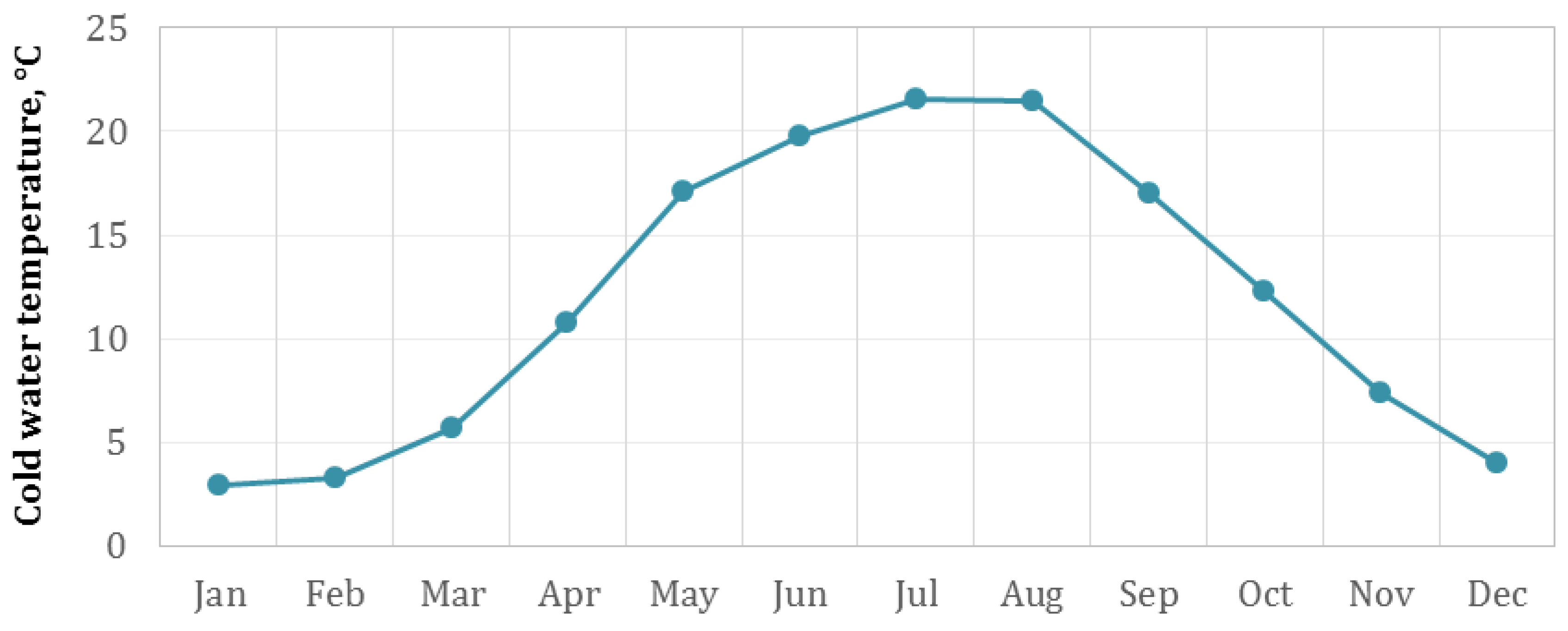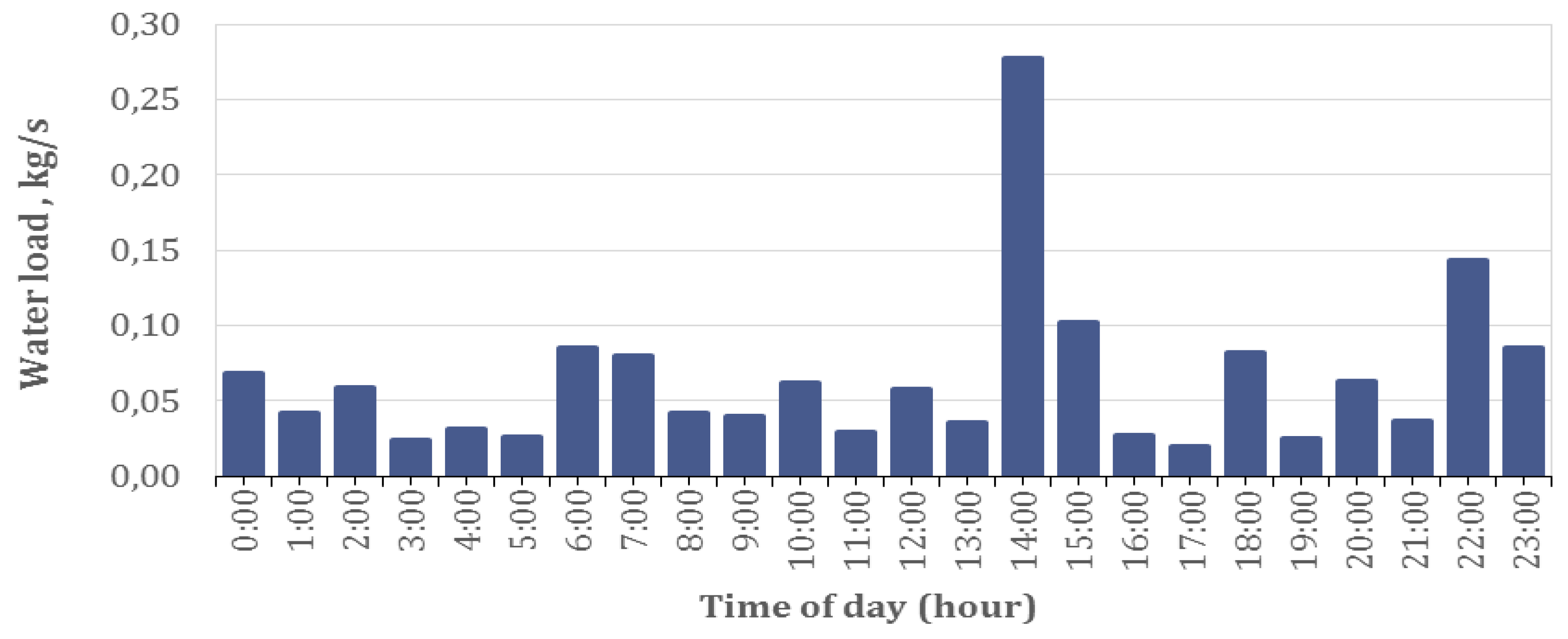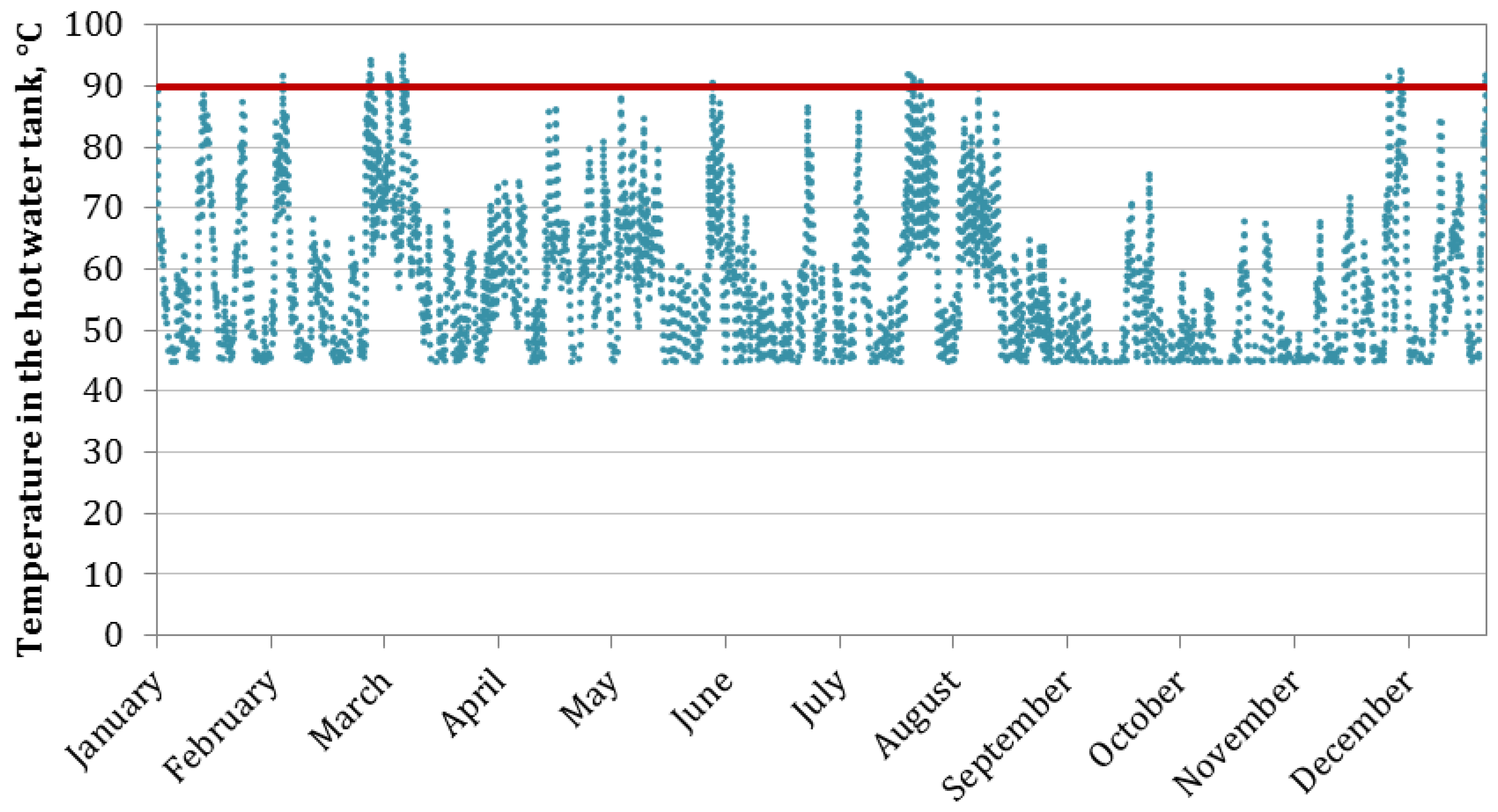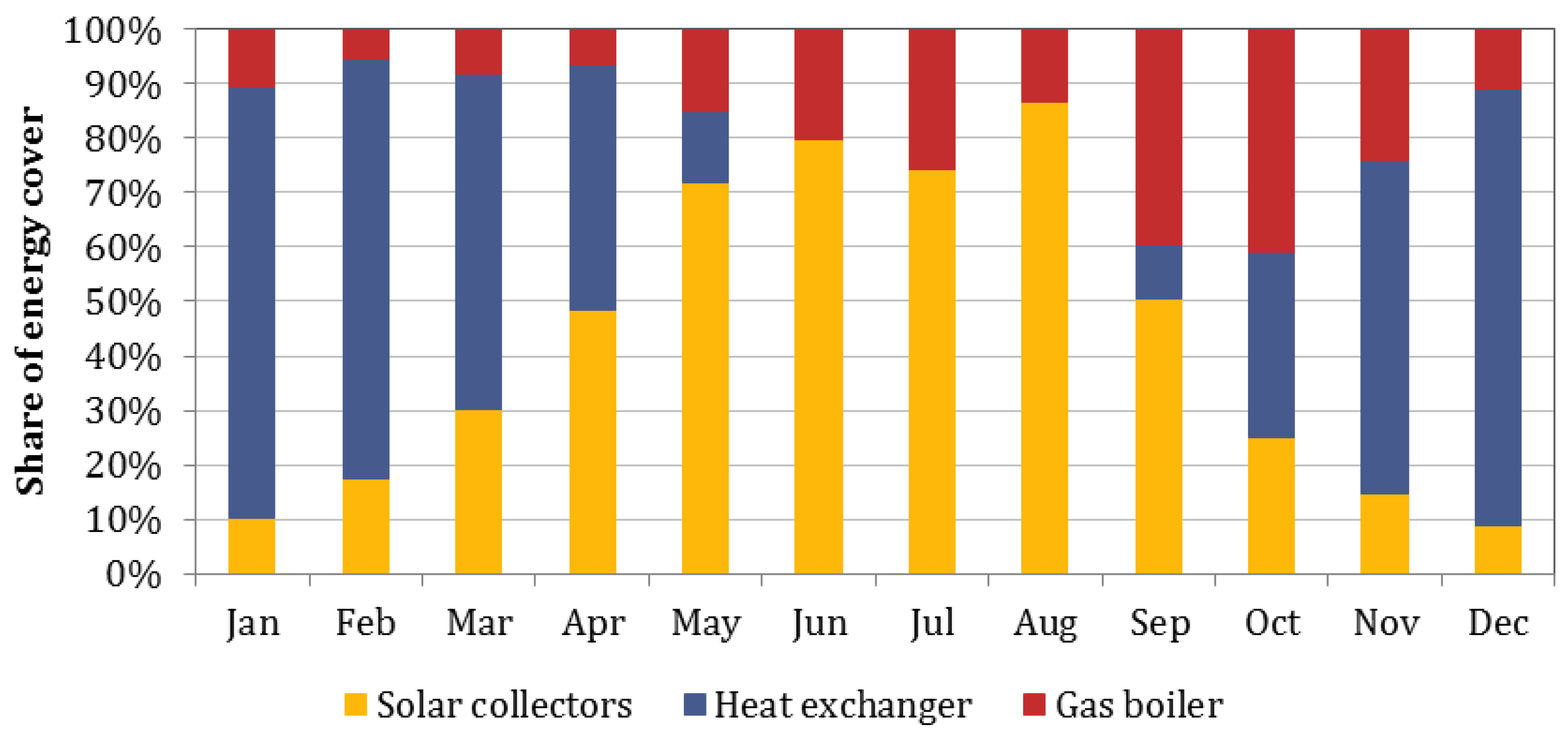Hybrid Domestic Hot Water System Performance in Industrial Hall
Abstract
1. Introduction
2. Materials and Methods
2.1. Industrial Hall Description
2.2. Energy Consumption for Hall Heating
2.3. Hot Water Preparation System and Analysis Methodology
2.3.1. Solar Sources
2.3.2. Waste Sources
2.3.3. Gas Boiler
2.4. Data of Supply Water Temperature Change
2.5. Hot Water Consumption Profile Data
3. Results and Discussion
4. Conclusions
Author Contributions
Funding
Acknowledgments
Conflicts of Interest
References
- Chris, F.; Khaled, T. Development of an Industrial Environmental Index to Assess the Sustainability of Industrial Solvent-Based Processes. Resources 2019, 8, 115. [Google Scholar]
- Staniaszek, D.; Firlag, S. Financing Building Energy Performance Improvement in Poland, 2016. Available online: https://insights.ovid.com/crossref?an=00129804-200411000-00002 (accessed on 10 May 2020).
- Sayegh, M.A.; Danielewicz, J.; Nannou, T.; Miniewicz, M.; Jadwiszczak, P.; Piekarska, K.; Jouhara, H. Trends of European research and development in district heating technologies. Renew. Sustain. Energy Rev. 2017, 68, 1183–1192. [Google Scholar] [CrossRef]
- Rynek Inwestycyjny Nieruchomości Komercyjnych w Europie Środkowej w Drugim Kwartale 2015 r. Available online: https://nowoczesnehale.elamed.pl/archiwum[wydanie,27586,6,2015,27597]#27597 (accessed on 10 October 2019).
- Pezzutto, S.; Croce, S.; Zambotti, S.; Kranzl, L.; Novelli, A.; Zambelli, P. Assessment of the Space Heating and Domestic Hot Water Market in Europe—Open Data and Results. Energies 2019, 12, 1760. [Google Scholar] [CrossRef]
- Dudkiewicz, E.; Fidorów, N.; Jezowiecki, J. The influence of infrared heaters efficiency on the energy consumption cost. Rocz. Ochr. Srodowiska 2013, 15, 1804–1817. [Google Scholar]
- Sarbu, I.; Tokar, A. Numerical modeling of high-temperature radiant panel heating system for an industrial hall. Int. J. Adv. Appl. Sci. 2018. [Google Scholar] [CrossRef]
- Dudkiewicz, E.; Szałański, P. A review of heat recovery possibility in flue gases discharge system of gas radiant heaters. E3S Web Conf. 2019, 116, 00017. [Google Scholar] [CrossRef]
- Dudkiewicz, E.; Szałański, P. Overview of exhaust gas heat recovery technologies for radiant heating systems in large halls. Therm. Sci. Eng. Prog. 2020, 100522. [Google Scholar] [CrossRef]
- Ahmetović, E.; Grossmann, I. Optimization of water consumption in process industry. Slov. Chem. Days Maribor Slov. 2010, 1–10. Available online: http://tf.untz.ba/katedre/KatProcInz/TehOpe/index/AhmetovicGrossmannSKD-2010_PaperFormatted.pdf (accessed on 5 May 2020).
- Wojdalski, J.; Drózdz, B.; Piechocki, J.; Gaworski, M.; Zander, Z.; Marjanowski, J. Determinants of water consumption in the dairy industry. Polish J. Chem. Technol. 2013, 15, 61–72. [Google Scholar] [CrossRef]
- Cuviella-Suárez, C.; Colmenar-Santos, A.; Borge-Diez, D.; López-Rey, Á. Management tool to optimize energy and water consumption in the sanitary-ware industry. J. Clean. Prod. 2018, 197, 280–296. [Google Scholar] [CrossRef]
- Moro, M.A.; McKnight, U.S.; Smets, B.F.; Min, Y.; Andersen, M.M. The industrial dynamics of water innovation: A comparison between China and Europe. Int. J. Innov. Stud. 2018, 2, 14–32. [Google Scholar] [CrossRef]
- Reynaud, A. An Econometric Estimation of Industrial Water Demand in France. Environ. Resour. Econ. 2003, 25, 213–232. [Google Scholar] [CrossRef]
- Dudkiewicz, E.; Zabnieńska-Góra, A. Water load pattern in a production hall. E3S Web Conf. 2018. [Google Scholar] [CrossRef]
- Aki, H.; Wakui, T.; Yokoyama, R. Development of a domestic hot water demand prediction model based on a bottom-up approach for residential energy management systems. Appl. Therm. Eng. 2016, 108, 697–708. [Google Scholar] [CrossRef]
- Recknagel, H.; Sprenger, E.; Schramek, E.R.; Besler, G.J. Heating and Air Conditioning Compendium: Including Hot Water Preparation and Cooling Technology; OmniScala: Wrocław, Poland, 2008. [Google Scholar]
- Fuentes, E.; Arce, L.; Salom, J. A review of domestic hot water consumption pro fi les for application in systems and buildings energy performance analysis. Renew. Sustain. Energy Rev. 2018, 81, 1530–1547. [Google Scholar] [CrossRef]
- Ahmed, K.; Pylsy, P.; Kurnitski, J. Monthly domestic hot water profiles for energy calculation in Finnish apartment buildings. Energy Build. 2015, 97, 77–85. [Google Scholar] [CrossRef]
- Baneshi, M.; Bahreini, S.A. Impacts of hot water consumption pattern on optimum sizing and techno-economic aspects of residential hybrid solar water heating systems. Sustain. Energy Technol. Assess. 2018, 30, 139–149. [Google Scholar] [CrossRef]
- Dongellini, M.; Falcioni, S.; Morini, G.L. Dynamic Simulation of Solar Thermal Collectors for Domestic Hot Water Production. Energy Procedia 2015, 82, 630–636. [Google Scholar] [CrossRef][Green Version]
- Evarts, J.C.; Swan, L.G. Domestic hot water consumption estimates for solar thermal system sizing. Energy Build. 2013, 58, 58–65. [Google Scholar] [CrossRef]
- Ahmed, K.; Pylsy, P.; Kurnitski, J. Hourly consumption profiles of domestic hot water for different occupant groups in dwellings. Sol. Energy 2016, 137, 516–530. [Google Scholar] [CrossRef]
- Yao, R.; Steemers, K. A method of formulating energy load profile for domestic buildings in the UK. Energy Build. 2005, 37, 663–671. [Google Scholar] [CrossRef]
- Rankin, R.; Rousseau, P.G. Sanitary hot water consumption patterns in commercial and industrial sectors in South Africa: Impact on heating system design. Energy Convers. Manag. 2006, 47, 687–701. [Google Scholar] [CrossRef]
- Aerts, D.; Minnen, J.; Glorieux, I.; Wouters, I.; Descamps, F. A method for the identification and modelling of realistic domestic occupancy sequences for building energy demand simulations and peer comparison. Build. Environ. 2014, 75, 67–78. [Google Scholar] [CrossRef]
- Suganthi, L.; Samuel, A.A. Energy models for demand forecasting—A review. Renew. Sustain. Energy Rev. 2012, 16, 1223–1240. [Google Scholar] [CrossRef]
- Ibrahim, O.; Fardoun, F.; Younes, R.; Louahlia-Gualous, H. Optimal management proposal for hybrid water heating system. Energy Build. 2014, 75, 342–357. [Google Scholar] [CrossRef]
- Ibrahim, O.; Younes, R. Progress to global strategy for management of energy systems. J. Build. Eng. 2018, 20, 303–316. [Google Scholar] [CrossRef]
- Dudkiewicz, E.; Fidorów-Kaprawy, N. The energy analysis of a hybrid hot tap water preparation system based on renewable and waste sources. Energy 2017, 127, 198–208. [Google Scholar] [CrossRef]
- Słyś, D.; Pochwat, K.; Czarniecki, D. An Analysis of Waste Heat Recovery from Wastewater on Livestock and Agriculture Farms. Resources 2020, 9, 3. [Google Scholar] [CrossRef]
- Amanowicz, Ł.; Wojtkowiak, J. Validation of CFD model for simulation of multi-pipe earth-to-air heat exchangers (EAHEs) flow performance. Therm. Sci. Eng. Prog. 2018, 5, 44–49. [Google Scholar] [CrossRef]
- Pérez, F.J.D.; Martín, R.D.; Trujillo, F.J.P.; Díaz, M.; Mouhaffel, A.G. Consumption and emissions analysis in domestic hot water hotels. Case Study: Canary Islands. Sustainability 2019, 11, 599. [Google Scholar] [CrossRef]
- Krawczyk, D.A.; Żukowski, M.; Rodero, A.; Bilinskiene, R. Analysis of the solar collectors installation on a roof of the small public building in Poland, Lithuania and Spain—A case study. Proceedings 2018, 2, 1272. [Google Scholar] [CrossRef]
- Venegas-Reyes, E.; Ortega-Avila, N.; Rodriguez-Munoz, N.; Najero-Trejo, M.; Martin-Dominguez, I.; Ibarra-Bahena, J. Parametric methodology to optimize the sizing of solar collector fields in series-parallel arrays. Processes 2019, 7, 294. [Google Scholar] [CrossRef]
- Paska, J.; Sałek, M.; Surma, T. Current status and perspectives of renewable energy sources in Poland. Renew. Sustain. Energy Rev. 2009, 13, 142–154. [Google Scholar] [CrossRef]
- Pluta, Z. Solar Energy Installations, Poland; Publishing House of the Warsaw University of Technology: Warsaw, Poland, 2007. [Google Scholar]
- Jouhara, H.; Khordehgah, N.; Almahmoud, S.; Delpech, B.; Chauhan, A.; Tassou, S.A. Waste heat recovery technologies and applications. Therm. Sci. Eng. Prog. 2018, 6, 268–289. [Google Scholar] [CrossRef]
- Kordana, S.; Pochwat, K.; Słyś, D.; Starzec, M. Opportunities and Threats of Implementing Drain Water Heat Recovery Units in Poland. Resources 2019, 8, 88. [Google Scholar] [CrossRef]
- Dudkiewicz, E.; Fidorów, N.; Jezowiecki, J. Energy consumption analysis for radiant heating systems. Rocz. Ochr. Srodowiska 2013, 15, 2293–2308. [Google Scholar]
- Mardiana-Idayu, A.; Riffat, S.B. Review on heat recovery technologies for building applications. Renew. Sustain. Energy Rev. 2012, 16, 1241–1255. [Google Scholar] [CrossRef]
- Jaber, H.; Khaled, M.; Lemenand, T. Short Review on Heat Recovery from Exhaust Gas. In AIP Conference Proceedings; AIP Publishing LLC: Melville, NY, USA, 2016. [Google Scholar] [CrossRef]
- Huang, F.; Zheng, J.; Baleynaud, J.M.; Lu, J. Heat recovery potentials and technologies in industrial zones. J. Energy Inst. 2017, 90, 951–961. [Google Scholar] [CrossRef]
- Fidorów-Kaprawy, N.; Dudkiewicz, E. The impact of the hot tap water load pattern in the industrial hall on the energy yield from solar collectors. E3S Web Conf. 2017, 00044. [Google Scholar] [CrossRef]
- Chmielewska, A. Fluctuating temperature of the mains water throughout the year and its influence on the consumption of energy for the purposes of DHW preparation. E3S Web Conf. 2018, 44, 00017. [Google Scholar] [CrossRef]
- EDSLTas. Available online: http://www.edsl.net/main/Software.aspx (accessed on 1 September 2019).
- The Website of the Ministry of Infrastructure and Construction. Available online: http://mib.gov.pl/2-Wskazniki_emisji_wartosci_opalowe_paliwa.htm (accessed on 1 October 2019).
- Çomakli, K.; Çakir, U.; Kaya, M.; Bakirci, K. The relation of collector and storage tank size in solar heating systems. Energy Convers. Manag. 2012, 63, 112–117. [Google Scholar] [CrossRef]
- Hasanuzzaman, M.; Rahim, N.A.; Hosenuzzaman, M.; Saidur, R.; Mahbubul, I.M.; Rashid, M.M. Energy savings in the combustion based process heating in industrial sector. Renew. Sustain. Energy Rev. 2012, 16, 4527–4536. [Google Scholar] [CrossRef]







| Place of Consumption | Water Consumption (L/min) | Duration of Water Consumption (min) | Single Use Consumption (L/(person·day)) | Water Temperature (°C) | Heat Consumption (Wh) |
|---|---|---|---|---|---|
| Single washbasin | 10 | 3 | 30 | 35 | 870 |
| Collective washbasin | 5–10 | 3 | 15–30 | 35 | 500–870 |
| Shower in the collective bathroom | 10 | 5 | 50 | 35 | 1450 |
| Shower in the cabin | 10 | 15 | 80 | 35 | 2300 |
| Type of Data | Data for the Industrial Hall |
|---|---|
| Work shifts | 3 |
| Working days per week/shifts per week | 6/16 |
| Number of workers per day | 235 |
| Degree of soiling work | high |
| DHW sanitary equipment: | Washbasins and showers |
| Jan | Feb | Mar | Apr | May | Jun |
|---|---|---|---|---|---|
| 28.09 | 27.06 | 22.20 | 10.92 | 1.32 | 0.00 |
| Jul | Aug | Sep | Oct | Nov | Dec |
| 0.00 | 0.00 | 1.32 | 1.29 | 2.73 | 32.55 |
| Type of Data | Outcome for Industrial Hall |
|---|---|
| Mean temperature in tank of hot water (°C) | 55 |
| Mean daily DHW consumption per person (l/person) | 24 * |
| Mean daily DHW consumption Gd (m3) | 5.65 * |
| Mean weekly DHW consumption (m3) | 31.7 |
| Daily DHW energy demand (kWh) | 263 |
| Daily heat consumption per person (Wh/person) | 1120 |
| Weekly DHW energy demand (kWh) | 1474 |
| Mean monthly DHW energy demand (kWh) | 6201 |
© 2020 by the authors. Licensee MDPI, Basel, Switzerland. This article is an open access article distributed under the terms and conditions of the Creative Commons Attribution (CC BY) license (http://creativecommons.org/licenses/by/4.0/).
Share and Cite
Dudkiewicz, E.; Fidorów-Kaprawy, N. Hybrid Domestic Hot Water System Performance in Industrial Hall. Resources 2020, 9, 65. https://doi.org/10.3390/resources9060065
Dudkiewicz E, Fidorów-Kaprawy N. Hybrid Domestic Hot Water System Performance in Industrial Hall. Resources. 2020; 9(6):65. https://doi.org/10.3390/resources9060065
Chicago/Turabian StyleDudkiewicz, Edyta, and Natalia Fidorów-Kaprawy. 2020. "Hybrid Domestic Hot Water System Performance in Industrial Hall" Resources 9, no. 6: 65. https://doi.org/10.3390/resources9060065
APA StyleDudkiewicz, E., & Fidorów-Kaprawy, N. (2020). Hybrid Domestic Hot Water System Performance in Industrial Hall. Resources, 9(6), 65. https://doi.org/10.3390/resources9060065






